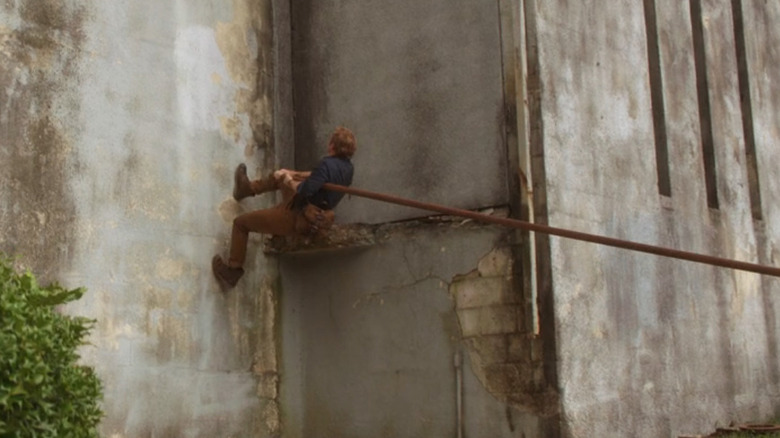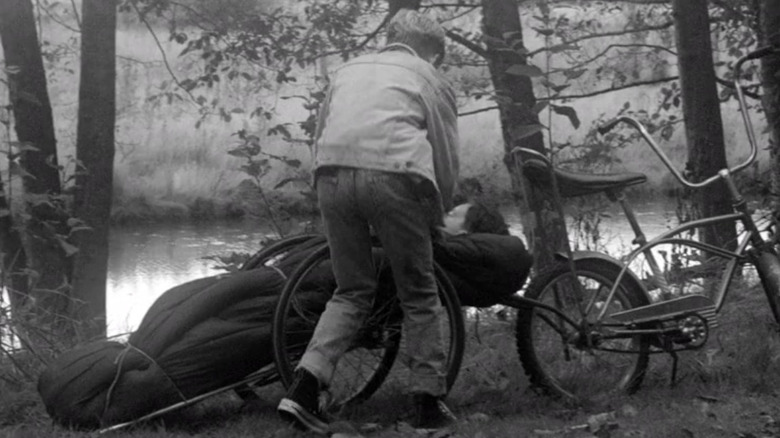MacGyver Hacks That Could Actually Work
We may receive a commission on purchases made from links.
The original television show "MacGyver" (1985) took a unique approach to action and adventure storytelling, focusing on a character whose primary attribute was resourcefulness. Again with the reboot of the series "MacGyver" (2016), the formula proved worthy enough to keep rolling — this time with a keener eye for fact-mindedness. The original series focused on feats of imagination held together with duct tape and actuated with a paper clip — to such a degree that "MacGyver" became a verb in our pop culture lexicon.
To "MacGyver" something is to solve a problem — or more specifically, fix a hardware issue — without the aid of the tools or instructions generally required for that situation. You'll find the term in several major dictionaries — it's still considered slang, but it's out there.
The 2016 reboot of the show ratchets up the science of the solutions used by the show's main character. Where the original show played it sort of fast and loose with reality, the "MacGyver" reboot hired a science consultant from "MythBusters" to give new MacGyvrisms a faint sense of plausibility. In both series, the viewer is meant to wonder: "could that actually work?"
We've got a list of MacGyver hacks that could actually work — leaving aside the bombs, weapons, traps, Rube Goldberg devices, and ordinary lifehacks you wouldn't be surprised to find a friend doing.
The chocolate antacid hack
The very first episode of the original MacGyver series featured our hero gumming up a sulfuric acid leak via the simple expedient of... chocolate bars. This is one of a handful of classic MacGyver episodes that captured people's imaginations so thoroughly that MythBusters ended up investigating it. The science here seems simple enough. The problem is that there's more than one theory floating around about how this happens, exactly. Is the acid being neutralized by the sugar — or something else in the chocolate bar? Is it really leaving behind carbon, as MacGyver suggests? And, of course, would it really work?
The good news is that MythBusters and a handful of real-life people have put this to the test, and all find it plausible. Kenneth Seldeen of Scientific AmeriKen successfully used chocolate to mostly neutralize a bit of vinegar. But Briana Northington's YouTube channel features a video that directly tested MacGyver's chocolate solution.
Depending on the exact sugars and acids involved, the reaction goes something like this: a simple sugar, combined with a strong acid, will dehydrate the sugar. That is, it will literally remove H2O from the sucrose, fructose, etc. This chemical reaction produces carbon dioxide, water, and heat (it is an exothermic reaction), which mostly or entirely vaporizes the water. What is left behind is graphite, a form of carbon, and in the case of MacGyver some dehydrated bits of chocolate that combine with the carbon to form the crack-sealing gummy paste.
The iron pipe-whack hack
Since dropping something down a hole or otherwise out of reach naturally results in the urge to hit things with a pipe, creating something like a natural experiment, it's surprising more people haven't discovered this trick on their own. In the original series season 1, episode 11, MacGyver whacks a pipe against a fire hydrant not out of anger, but because he knows a secret about magnetism. Though it might have been more of a sure bet to know a secret about chewing gum. This pipe-whacking results in the magnetization of the rod, which allows him to retrieve the antidote to the poison he's been given (which, fortunately, is enclosed in a magnetic tube).
It's also fortunate that the rod was nearly pure iron because this phenomenon only happens with certain crystalline structures. It's called the Villari Effect, but you'll often read that it's related to magnetostriction. This is true: magnetostriction is the phenomenon by which changing the magnetism of certain ferric structures changes the dimensions of that structure. The Villari effect, sometimes called inverse magnetostriction, is the inverse effect: physically stressing the iron causes the rod to become magnetized, a potential boon to droppers of keys, bolts, and poison antidotes everywhere.
Not only is this workable, but it also works every day. The Villari Effect is used in force sensors, a kind of load cell that can be used, for example, to measure torque, as it is with these BoltSafe magnetoelastic sensors.
The duct tape diaper hack
This one probably violates our "no obvious hacks" rule, but it would be negligent to not have at least one duct tape-related hack from MacGyver. Not every MacGyverism has practical value in the real world, but this one does... sort of. In season 3, episode 18 of the original series, MacGyver improvises a diaper fastened with duct tape. Probably not the most hypoallergenic or absorbent solution, but at least one real-world mom with a real child has found it useful.
Diaper fastening methods have undergone a rapid evolution since the retronym "cloth diaper" first came about. We've tried all manner of pins, snaps, clips, hooks, and tapes, continually refining them for safety, comfort, and ease of use. In the 1970s, adhesive tape closures became a thing, and disposable diapers using such tapes are still available today, though they've largely been replaced by hook-and-loop tape. MacGyver's duct tape solution is basically a variety of this design, but worse. The big, ahem, sticking point is the ability to reposition the diaper closure. If you've ever diapered a baby, you know that they are disinterested in or, worse, irritated by diaper changes, and not always prone to cooperation.
Using two hands to unspool duct tape and then taking your one shot at placing it perfectly probably isn't optimal. But it should work, in the sense that you can now get rid of the soiled diaper. And that, ultimately, is the most important thing.
The watertight egg white radiator hack
You've just driven to town to buy some eggs for breakfast, and discover that your radiator has leaked away all its coolant. MythBusters had a look at MacGyver's season 2, episode 19 attempt in a similar situation (but with gunfire), to repair a leaky radiator with egg whites. They concluded that it just might work, very temporarily. We've seen claims that this is an old Army trick, but we wouldn't suggest trying it with powdered eggs. Or trying it at all, really.
The idea is simply that the egg whites will cook and find their way to the leak, where pressure will lodge them temporarily, stopping the leak. This might work, although you can imagine how strong the fix is from how easily destroyed even the most rubbery of cooked eggs is. And it is probably a solution in search of a problem, given that almost any solution would be a better idea. Parkside Motors, a car repair shop, specifically addresses the MacGyver hack and suggests it only as a "very VERY last resort," and quite reasonably finds it unlikely that you'd have an egg in such a situation. There's a good chance the solution will destroy your car's heater core, and extracting the cooked eggs from every nook and cranny might be a pricey process. Parkside, based in Victoria, British Columbia, recommends visiting Canadian Tire for some Stop Leak, which might be even less convenient and more expensive than the egg debacle if you don't happen to be in Canada.
The flour power pursuer-loser hack
The 2016 reboot not only rewarded viewers with a new Angus MacGyver, but as a bonus, fans also got a superb nerd, Rhett Allain, the show's technical advisor, who formerly advised "MythBusters." Allain took to Youtube, Wired, a couple of blogs, and a series of CBS videos called Mac Hacks to explain the science behind the new series. Season 1, episode 4 of the reboot featured a few interesting hacks, but the flour explosion one stands out for being both feasible and, you know, a flour explosion.
Explosion? You're surely asking why we're violating another of our ground rules. But a flour explosion is usually the product of neglect, not bomb-making, and Allain describes the stunt as "only slightly dangerous." So don't try this at home; in fact, try to avoid it at home, and not just in the kitchen. The Washington State Department of Labor & Industries says all you need is a spark and sawdust in the air inside an enclosed space to start a deadly chain reaction of explosions in places like sawmills and woodworking shops. Sawdust explosions function exactly as flour explosions do: extremely fine particles of either are flammable, and confining their burning to a fixed space like a machine or a room turns a tiny fire into a big explosion as expanding gases trying to find the amount of space they require.
Better to see it than experience it. Allain shows you how it's done (outside, with everything in small quantities and under control) on his YouTube channel. He actually has another, more elaborate video on this topic ("Making a Fireball with Flour"), if you prefer more drama.
The wall-scaling pole hack
Occasionally, MacGyver's tricks are based on real-life hacks. In season 2, episode 1 of the 2016 series, called DIY or DIE (surely the MacGyver credo), MacGyver scales the walls of a fortified building with the aid of two associates, a long pole, and physics. Turns out, there's at least one video out there of Vietnamese law enforcement using the same trick. The climber holds onto one end of the pole and walks up the wall, while two (or more, or conceivably fewer) people push the pole toward the wall that's being climbed.
This sounds like something you don't really want teenagers to know about, and it might be. But if they find out, at least have them learn the physics behind the trick, which Allain wrote up for Wired, complete with diagrams. There are a few forces at play here, but mostly you're interested in the friction of the climber against the wall and the upward force of the pole. At the beginning of the climb, the pole is mostly horizontal and so most of the force goes to friction... ideal, since there's not much upwards push yet. Then, as the angle increases, the force shifts from friction to lift, up to 90 degrees... at which point, of course, the climber is just a guy hanging onto a pole.
The 'where was I last night' math hack
For most people, this is probably one of the more boring Mac Hacks... but it would absolutely work. MacGyver even bails out of explaining it to his comrades, whose eyes glaze over almost instantly. Basically, what he's up to in season 2, episode 4 of the reboot is using math to triangulate his position relative to some church bells and a fire alarm.
Our hero has been drugged (again) and is later trying to recreate the situation mentally to figure out his location. He recalls hearing church bells and a fire alarm and can identify the exact starting time of each. Knowing the speed of sound, and that both sounds reached him at about the same time, MacGyver gets a pretty good approximation of his location. Basically, you map the two points from which sound originated as expanding circles representing the soundwave. Where those circles intersect (there are two such points) is where MacGyver must have been when he heard them. Rhett Allain explains it in a video that appears to have been created for someone at CBS, which gives us an interesting peek into the creative process for this kind of thing.
If you're still confused, that's okay. It's difficult to imagine a practical application for this. Maybe finding your car after a wild night out? But if you can't master it, take heart from this sentence, which is a funny admission of complexity and difficulty from Allain's blog, a professional educator: "It's sort of like the opposite of [timing the difference between lightning and thunderclap] problem except that it's totally different."
The light modulation sound communication hack
Season 2, episode 12 of the 2016 series features one of the coolest MacGyverisms: transmitting sound via light. MacGyver listens in on a conversation from a distance using a photocell and a laser (though Allain says it's actually easier with an LED bulb). The basic principle is actually pretty easy to demonstrate, in spite of the fact that MacGyver's trick seems like nonsense TV magic. In the show, MacGyver and his team hack together a two-way device that incorporates a garden solar light, karaoke microphone, boombox, porch light, and possibly a kitchen sink, off-camera. But Rhett Allain demonstrates a much simpler version, which makes the idea clearer.
As explained in the show, this is essentially a photophone... a device invented by Alexander Graham Bell (yes, that Alexander Graham Bell) that modulates the brightness of a given light source according to voice input. On the other end, a device (a solar panel works perfectly) reads the signal and translates it back into sound (through an amplified computer speaker, in the case of Allain's example). It's really fairly simple, as you'd expect from something invented in 1879-80. If you'd like to dive as deep as possible into the photophone, a long-defunct company called Bluehaze Solutions used to feature an excellent (despite its Web 1.0 appearance) article on its site, which is a very thorough treatment originally from the Wireless Institute of Australia's "Amateur Radio" magazine.
"My favorite hacks are based on real science with stuff that someone could actually do at home. Perhaps my favorite was the photophone from 'Mac + Jack,'" Allain told CBS in 2018. "The photophone uses a changing light source detected by a photocell to transmit sound via light. It's awesome and you could build one yourself."
The elevator balancing act hack
This one is a little different, in the sense that it didn't work for MacGyver, but it might work for you. In the reboot's season 3, episode 22, Jack is held hostage in an elevator rigged to fall, and MacGyver runs all the complex calculations needed to reduce the acceleration of the falling elevator by linking it to a second elevator car. This is a classic Atwood Machine problem, a hypothetical device used in physics instruction. The hypothetical device has a frictionless pulley and a massless string, but the real-world elevators MacGyver is dealing with have very real forces acting upon them, making things more complicated for our hero. Unfortunately, MacGyver never gets the chance to try it, about which we will say no more.
Why might this complicated bit of calculation work for you? Allain hashes it all out in a video, factoring in cable stretch (which is affected by cable tension, length, diameter, and material), and a mathematically and scientifically inclined mortal might be able to follow it with plenty of pausing.
Why might this not work for you? Firstly, because you seem to have developed an inexplicable fear of elevators after watching this episode of MacGyver. And as far as we can tell, Allain never accounts for the real-world pulley friction and cable mass.
The how-to-become-MacGyver hacks
Back to the first MacGyver for some inspiration. In season 4, episode 2, MacGyver flashes back to his preteen self, hacking together a sort of bike trailer for transporting an injured friend. This works, but the childhood friend dies anyway, and it's not hard to see how that formative experience shaped the MacGyver of today. We can't say how badly you need a bike trailer at the moment — and you can certainly follow Mac's blueprint to make your own — but so much more happened in this flashback, psychologically. Who can't do with a few lifehacks to make you more inventive and helpful, and possibly pathologically terrified of failure? So, you don't need a childhood trauma to draw on in order to cultivate a little MacGyver in yourself.
It turns out that there are a lot of resources for this very purpose, all associated with the MacGyver mythos. The creator of the original MacGyver series, Lee David Zlotoff, has many such resources at macgyver.com in a section conveniently named "Be MacGyver." There's a problem-solving guidebook co-authored by Zlotoff; a charity, the MacGyver Foundation, promoting the use of "self-reliance, non-violence, and sustainability to improve people's lives"; and one you didn't see coming... MacGyver: The Musical, is a whimsical invention that features someone chosen from the audience to play MacGyver. This is not a joke.
Rhett Allain shows up again, this time as the author of The Official MacGyver Survival Manual, a massive, ironically named collection of things that could get you killed, arrested, or both.










